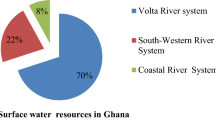Abstract
We analyze the driving mechanism of the River-Director System reform in the article. Using the ordered probit model, the effect of the River-Director System policy was evaluated by observing the monthly water quality data of 170 water areas along the boundary of the Yangtze River system. It determines that the driving force of the local government’s basin governance under the river system is mainly the top-down policy directives and that the driving path is effective synergy, rights, and diffusion in the article. We find that the upstream provinces and municipalities that implemented reforms have significantly improved the water quality of the waters in the border basin, compared with the provinces and cities that have not implemented the reform of the river system and the river basins that have implemented policy reforms but are located in the lower reaches of the rivers. At the same time, the city’s reforms have significantly improved the quality of the junction basin water body. The implementation of the River-Director System has reduced the occurrences of local pollution emission and improved the water quality of the provincial boundaries through sewage treatment. We further validate the robustness of the basic conclusions by deleting special samples and changing the window type and other robust tests. Finally, through monthly examinations on the implementation of the policy, it finds that the effectiveness of the policy reform became more apparent in the eleventh month.
Similar content being viewed by others
Notes
Most of China’s provinces and cities have established a joint inter-ministerial meeting long river system at its core, and contact meeting, head of the Ministry of Water Resources as the core. Departments that participated include the Ministry of Land and Resources, Ministry of Housing and Urban-Rural Development, Rainbow Department, the Forestry Bureau, the National Development and Reform Commission, Ministry of Transport, Ministry of Finance, the Environmental Protection Department, and members of the Joint Meeting of the Ministry of Agriculture, Health, and Family Planning Commission, among others.
Due to the length of the article, the pre-implementation trend chart of the river length system for the treatment group and the control group is not given. Readers who need it can get it from the author.
Due to the limitations of space, the article did not give the results of the placebo test. Readers who need it can ask the author for the results.
Given that the provinces of Jiangsu and Zhejiang have fully implemented the reform of the river system as early as the beginning of the sample, the policy values of the relevant monitoring points are set to 0.
The article sets the dummy variables for the first 11 months of the policy to carry out an orderly probit model regression, but limited to the length, did not report the results, and did not give the regression results of the treatment group. The readers can ask the author for the results should they wish to view it.
References
Adelman DE (2014) Environmental federalism when numbers matter more than size. J Environ Law Policy 32(2):238–281
Assetto VJ, Hajba E, Mumme SP (2003) Democratization, decentralization, and local environmental policy capacity: Hungary and Mexico. Soc Sci J 40(2):249–268
Brollo F, Nannicini T, Perotti R, Tabellini G (2013) The political resource curse. Am Econ Rev 103(5):1759–1796
Chirinko RS, Wilson DJ (2017) Tax competition among U.S. states: racing to the bottom or riding on a seesaw?[J]. J Public Econ 155(11):147–163
Cole MA, Fredriksson PG (2009) Institutionalized pollution havens. Ecol Econ 68(4):1239–1256
Dijkstra BR, Fredriksson PG (2010) Regulatory environmental federalism. Ann Rev Resour Econ 2(1):319–339
Dong BM, Gong J, Zhao X (2012) FDI and environmental regulation: pollution haven or a race to the top? J Regul Econ 41(2):216–237
Kostka G, Nahm J (2017) Central–local relations: recentralization and environmental governance in China. China Q 231(9):567–582
Lai YB (2013) The superiority of environmental federalism in the presence of lobbying and prior tax distortions. J Public Econ Theory 15(2):341–361
List JA, Gerking S (2000) Regulatory federalism and environment protection in the United States. J Reg Sci 40(3):453–471
Madiès T, Dethier JJ (2012) Fiscal competition in developing countries: a survey of the theoretical and empirical literature. J Int Commerce Econ Policy 3(2):1–31
Millimet DL, Roy J (2015) Empirical tests of the pollution haven hypothesis when environmental regulation is endogenous. J Appl Econ 31(4):623–645
Qian YY, Roland G (1998) Federalism and the soft budget constraint. Am Econ Rev 88(5):1143–1162
Sigman H (2014) Decentralization and environmental quality: an international analysis of water pollution. Land Econ 90(1):114–130
Veld KV, Shogren JF (2012) Environmental federalism and environmental liability. J Environ Econ Manag 63(1):105–119
Acknowledgments
The authors would like to thank Vesterinen Anna-Mari, Juncheng Feng, all those who contributed to this paper.
Funding
This research was supported by National Social Science Fund Youth Project (Project Number. 18CJY021).
Author information
Authors and Affiliations
Corresponding author
Additional information
Responsible editor: Xianliang Yi
Publisher’s note
Springer Nature remains neutral with regard to jurisdictional claims in published maps and institutional affiliations.
Rights and permissions
About this article
Cite this article
Wang, J., Song, Y. Effect of water pollution control on provincial boundaries of River-Director System: based on the study of the Yangtze River valley in China. Environ Sci Pollut Res 27, 35217–35227 (2020). https://doi.org/10.1007/s11356-020-09684-2
Received:
Accepted:
Published:
Issue Date:
DOI: https://doi.org/10.1007/s11356-020-09684-2




